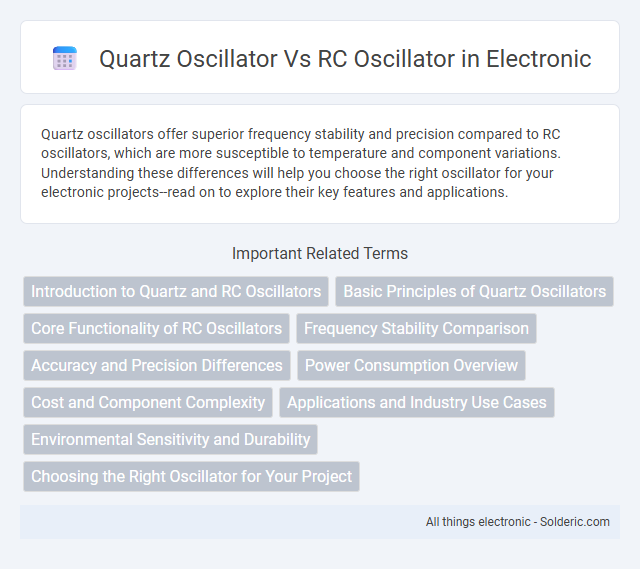Quartz oscillators offer superior frequency stability and precision compared to RC oscillators, which are more susceptible to temperature and component variations. Understanding these differences will help you choose the right oscillator for your electronic projects--read on to explore their key features and applications.
Comparison Table
| Feature | Quartz Oscillator | RC Oscillator |
|---|---|---|
| Frequency Stability | High (+-10 ppm or better) | Low (+-1% or worse) |
| Frequency Range | Few kHz to 100 MHz | Low frequency, typically below 1 MHz |
| Accuracy | Very high, precision-tuned | Moderate, dependent on RC components |
| Temperature Sensitivity | Minimal (temperature-compensated) | Significant, varies with component values |
| Cost | Higher, due to quartz crystal | Lower, uses resistors and capacitors |
| Size | Small but rigid structure | Can be integrated on-chip, smaller |
| Power Consumption | Low to moderate | Generally low |
| Applications | Clocks, communication, precise timing | Simple timing circuits, audio generators |
Introduction to Quartz and RC Oscillators
Quartz oscillators utilize the piezoelectric properties of quartz crystals to generate highly stable and precise frequency signals, making them essential in applications requiring accurate timing such as clocks, radios, and communication systems. RC oscillators rely on resistor-capacitor networks to produce oscillations, offering simplicity and low cost but with less frequency stability and precision compared to quartz oscillators. The distinct operational mechanisms and performance characteristics determine their suitability for various electronic circuits and timing applications.
Basic Principles of Quartz Oscillators
Quartz oscillators operate based on the piezoelectric effect, where a quartz crystal vibrates at a precise resonant frequency when an electric field is applied, producing highly stable and accurate oscillations. The crystal's mechanical resonance provides superior frequency stability and low phase noise compared to RC oscillators, which rely on resistor-capacitor networks to generate oscillations with less precision. Quartz oscillators are widely used in applications requiring precise timing, such as clocks, radios, and communication devices.
Core Functionality of RC Oscillators
RC oscillators generate oscillations using resistor-capacitor networks to produce a stable frequency signal typically in the audio to low radio frequency range. Your application benefits from their simplicity, low cost, and ease of integration in circuits requiring moderate frequency stability. These oscillators rely on phase shift and feedback through RC components to maintain continuous oscillation.
Frequency Stability Comparison
Quartz oscillators exhibit superior frequency stability compared to RC oscillators due to the high-quality factor (Q) of quartz crystals, which minimizes frequency drift over time and temperature variations. RC oscillators rely on resistors and capacitors with lower Q factors, making their frequency more susceptible to environmental changes and component aging. As a result, quartz oscillators are ideal for applications demanding precise and reliable frequency control, such as communication systems and timing devices.
Accuracy and Precision Differences
Quartz oscillators provide superior accuracy and precision due to their stable piezoelectric crystal frequency, typically exhibiting frequency stability within +-10 ppm or better over temperature variations. RC oscillators rely on resistor-capacitor networks, which are more susceptible to component tolerances and temperature changes, resulting in lower frequency stability often around +-1% or worse. This inherent difference makes quartz oscillators the preferred choice for applications requiring precise timing and frequency control, such as communication systems and instrumentation.
Power Consumption Overview
Quartz oscillators exhibit significantly lower power consumption compared to RC oscillators due to their stable frequency output and high-quality factor (Q factor), making them ideal for battery-powered devices requiring long operational life. RC oscillators, while simpler and cheaper, consume more power as they rely on continuous charging and discharging of resistors and capacitors, causing inefficiency in power-sensitive applications. Your choice between these oscillators should consider quartz oscillators for minimal energy use and high frequency stability in precision electronics.
Cost and Component Complexity
Quartz oscillators typically incur higher costs due to the precision quartz crystal required, making them more expensive compared to RC oscillators, which utilize inexpensive resistors and capacitors, keeping component costs low. The complexity of quartz oscillators is greater because they demand careful crystal trimming and stabilization circuitry, whereas RC oscillators have simpler construction and easier tuning. Cost-sensitive and low-frequency applications often favor RC oscillators, while high-stability requirements justify the premium of quartz oscillators.
Applications and Industry Use Cases
Quartz oscillators are widely used in telecommunications, aerospace, and precision instrumentation due to their high frequency stability and low phase noise, making them ideal for GPS receivers, radio transmitters, and medical devices. RC oscillators find applications in low-cost consumer electronics, audio circuits, and microcontroller timing where moderate frequency stability is sufficient and cost constraints dominate. Industrial automation, embedded systems, and signal processing often leverage the inherent advantages of both oscillator types depending on the required accuracy and environmental robustness.
Environmental Sensitivity and Durability
Quartz oscillators exhibit superior environmental stability and durability due to their crystalline structure, which resists temperature variations, humidity, and mechanical shock. RC oscillators, relying on resistors and capacitors, are more susceptible to drift caused by temperature fluctuations and aging components, leading to less reliable frequency stability. This makes quartz oscillators the preferred choice in precision timing applications where environmental robustness is critical.
Choosing the Right Oscillator for Your Project
Quartz oscillators offer superior frequency stability and precision, making them ideal for applications requiring accurate timing such as communication systems and high-frequency circuits. RC oscillators provide flexibility and lower cost, suitable for less stringent timing needs in audio or simple timing circuits. Evaluating the trade-offs between stability, cost, and circuit complexity helps determine the most appropriate oscillator type for your project.
Quartz oscillator vs RC oscillator Infographic

 solderic.com
solderic.com